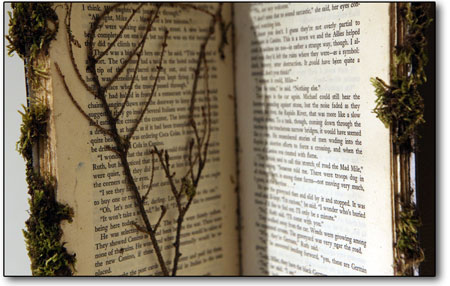|
|
Postcards from the land
‘Gathered Spaces’ provides miniature glimpses into time and space
by Stew Mosberg
Exhibitions in the DAC’s Barbara Conrad gallery typically coincide with a Friends of the Arts Library (F.O.A.L) show. The current 38th Annual Juried Exhibition (through Aug. 9) is no exception and is an impressive body of work in its own right.
As interesting as the Juried Exhibit is however, the upstairs venue features a more unusual artistic experience: the serenity of 21 self-contained environmental artifacts created by Leslie Madigan.
According to Madigan, the exhibition – titled “Gathered Spaces” – explores “Our relationship to the land with created environments that record a collected individuality of a place.”
JusttheFactsWhat: “Gathered Spaces” by Leslie Madigan
Where: DAC library, 802 E. 2nd Ave. When: Through Aug. 30 |
Madigan (formerly Leslie Scheiblberg) served as the first director of the Durango Arts Center, from 1981-88, and was one of its founding members. She later moved to Hastings on Hudson, N.Y., but exhibits on occasion in Durango. Her last exhibit in Durango was “The Book Unbound Redux,” in 2004. It was local artist and close friend Mary Ellen Long who urged Madigan to show here again when Long was visiting Madigan two years ago. “When the exhibition was offered (to me),” Madigan said, “I was thrilled to be given dates in the summer of 2014.”
The F.O.A.L., established by Long in 2005, includes five members: Deborah Gorton, who will be the next exhibitor in the library; Louise Grunewald; Barbara Klema; Long; and Jane Steele – all accomplished artists.
The goals and mission of the group has always been about art education and to bring six exhibits a year to the DAC that might not otherwise be seen. The work showcases local as well out-of-town artists, and because of the limited space, tends to be smaller scale, yet always distinctive. For the uninitiated, the library is one of the best art book resources in the county and also includes periodicals and videos on historical and contemporary art and artists.
As for the current exhibit, Madigan preserves natural environments in miniature formats that encompass places she has visited. Gathering and assembling materials she discovers in the forest or perhaps on a beach, Madigan incorporates used books or jars, which she refers to as “journey jars,” and creates tiny environments that record her visits.
The work in this particular exhibit covers the years 2008-13 and includes a residency in Ireland, as well as travels in the around the United States, and also near her home in the Hudson Valley, just north of New York City.
Terrariums and bonsai plants come to mind when viewing the diminutive ecospaces; they are treated with delicacy and might include handmade papers, pastel coloration, coins, moss, leaves, flowers or stones. The resulting pieces present a color palette that reflects the earth in all its organic naturalness. There are also tiny book shapes, sandwiching indigenous elements between covers that might be made of leaves, exotic paper or authentic old books. One of her pieces, “Taking Out and Putting Back,” utilizes a hollowed-out book to which she has added natural elements.
Madigan said that the displayed work was created in a series from specific locations and were chosen for the DAC show based on the size of the exhibition space. “I installed (it) with my son, Wolf Scheiblberg and utilized the shelves designed for the work.”
Further describing the evolution of the exhibit, Madigan said the idea reaches back to 2006 while she was in Ballyvaughan, Ireland. “The elements in this body of work contain the essence and physicality of a visited place: the act of touching, moving and gathering indigenous materials ... Our relationship to the land is a commonality we all share,” she said.
Her act of collecting and assembling a record of a visited locale gives the viewer a moment of contained time with a connection to a specific environment. Referring to the tiny book assemblages, the artist admits to seeking the idyll. “The book format suggests a transfer of knowledge,” she explained, “A return to the order and awareness of the natural world.”
.jpg) A close up of Madigan’s “Falling I” and “Falling II,” which will be on display through Aug. 30./ Photo by Steve Eginoire |
The pieces on display in the library are described on check lists placed around the room. Each piece is numbered with a tiny push-pin that corresponds to the list. The descriptions provide a title to reference the location where the items were gathered. The journey jars are layered on the bottom with the materials collected, dated, embellished and stuffed with collected elements. The stacked books also reference the locations and use leaves to represent pages. Altered books are covered with buds that have fallen to the ground and the moss gathered from the ground below. “The bodies of work,” she says, “are all connected to the act of the plants growing and their demise in the natural world.” Sale prices are also included in the information and range from $400 to $600.
Asked to describe the process by which she forms these microcosms and also how a collector can keep them fresh, Madigan willingly shared her method. “I use a formula from The New York Botanical Garden to preserve the organic materials. Then I varnish the work. The work should not have extended sunlight and be rotated.”
Madigan’s future plans include creating book forms built from carved shale that she hopes will suggest an outdoor library environment.
As for the arts center Madigan helped start, she is proud of what it has become. “The Arts Center has expanded and grown into a well-run and professional community arts center servicing the citizens of Durango,” she remarked.
Exhibitions like this manifest that growth.

